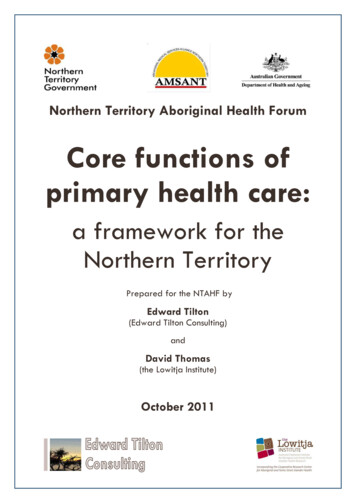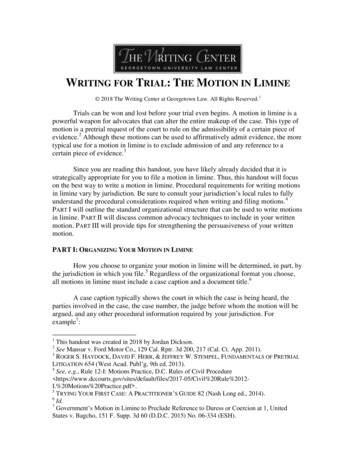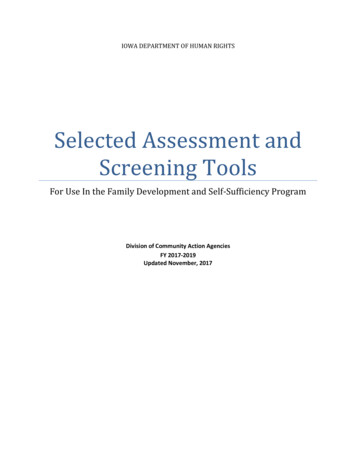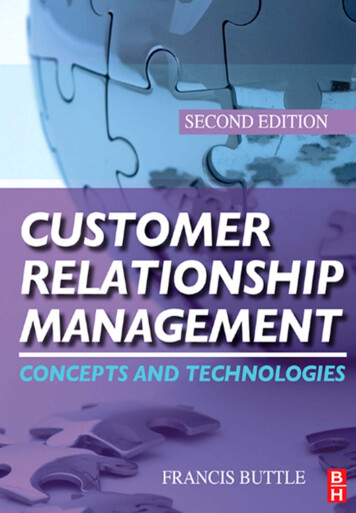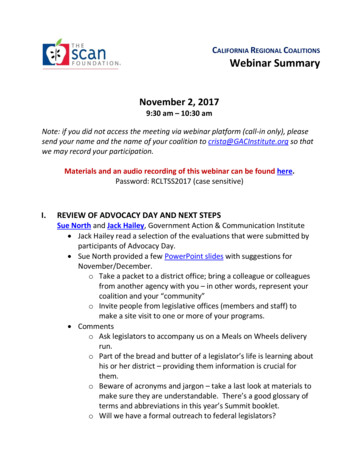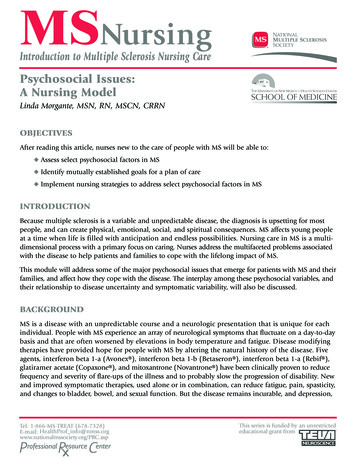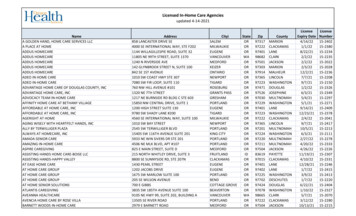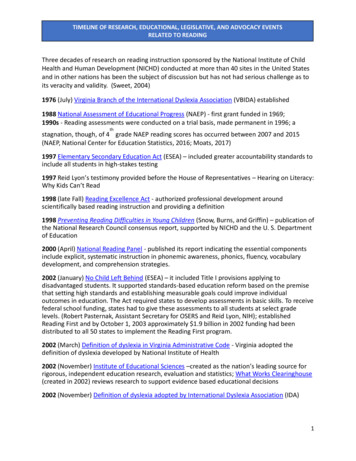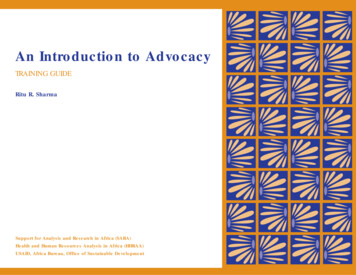
Transcription
An Introduction to AdvocacyTRAINING GUIDERitu R. SharmaSupport for Analysis and Research in Africa (SARA)Health and Human Resources Analysis in Africa (HHRAA)USAID, Africa Bureau, Office of Sustainable Development
An Introduction to AdvocacyTraining GuideBy Ritu R. SharmaSupport for Analysis and Research in Africa (SARA)Health and Human Resources Analysis for Africa (HHRAA)U.S. Agency for International Development, Africa Bureau, Office of Sustainable DevelopmentSARA/AED Advocacy Training Guide
The SARA Project is operated by the Academy forEducational Development with subcontractorsTulane University, JHPIEGO, Macro International,Morehouse School of Medicine, PopulationReference Bureau, and Porter/Novelli. SARA isfunded by the U.S. Agency for InternationalDevelopment (AFR/SD/HHR) under ContractAOT-0483-C-2178-00 (Project number 698-0483).SARA /AED Advocacy Training Guide
AcknowledgmentsThis guide would not have been possible without the invaluable insights,feedback, guidance and patience of Suzanne Prysor-Jones, Judy Brace,Lalla Touré, Barky Diallo, Lillian Baer, Ellen Piwoz, Dana Faulkner,Rhonda Smith, Renuka Bery and Lisa VeneKlasen. I am particularlygrateful to Renuka Bery for her outstanding layout design. Thanks arealso due to Anne MacArthur, Kim Hemphill and Cindy Arciaga for theirassistance throughout the development and production of this advocacyguide. Special thanks to InterAction, the Center for Development andPopulation Activities, Population Reference Bureau, and the AdvocacyInstitute for sharing their ground-breaking work on advocacy.SARA/AED Advocacy Training GuideReferences
ForewordWhy an Advocacy Training Guide?Over the past few years, the SARA Project has worked with several African institutions and partners to generate research findings and present information to decisionmakers in appropriate forms. Recognizing that this has not been enough to changepolicies and programs, aSARA study,Knowledge Utilization and the Process ofPolicy Formation, reviewed the process of policy change, and identified the threeactivities that converge to produce changes in policies and programs: identifying problems, finding solutions, and advocacy. While defining problems and exploring alternative solutions have long been used to promote change, the need for systematic anditerative advocacy in this process has been less well understood. The diagram showsthat the advocacy process is critical in precipitating changes in policies and programs.AdvocacyChanges in policiesand y, researchers, managers, NGO personnel, and other concerned groups andindividuals have found it necessary to become advocates, but they often have littleknowledge of or training in the subject. As we and our collegues in Africa recognizedmore fully the need for advocacy, we looked for introductory materials that could beeasily adapted and used at low cost in different local settings, but found few.ReferencesiSARA /AED Advocacy Training Guide
usingnguisThis Introduction to Advocacy Training Guide provides the tools for people to startengaging in the advocacy process, and is thus designed to: inform a diverse audience of potential advocates about advocacy and its methods;build some basic skills in advocacy;increase the use of available data to inform the advocacy process;give confidence to those who are embarking on advocacy efforts;encourage the democratic process by providing people with the skills to make theirvoices heard.Who will find the Guide useful?The Guide should be useful to people in all sectors who wish to improve policies andprograms through advocacy. Potential users may be: professional institutions, associations and networks;researchers interested in promoting their findings;program managers who wish to influence their agencies and/or the public;NGOs or community organizations;ad hoc groups that may form to address particular issues;training institutions or groups that work with potential advocates.SARA/AED Advocacy Training Guideii
How can the Guide be used and adapted?Although the Guide is written primarily for use in training sessions, it can also be usedby potential advocates as a tool to help them start their own advocacy work. Selected chapters can be used for one or two-day sessions that can be added tomeetings or conferences to give a general orientation on advocacy.Institutions, networks, or associations can use it with their staff and members asa guide to help plan particular advocacy campaigns.Researchers can use it to plan the dissemination of findings on particular issues.It can be used for pre-service training, using simulated issues for advocacy.Any or all examples in the Guide can be replaced by examples from othersectors.We hope that this Introduction to Advocacy Training Guide will enable diversegroups in Africa and elsewhere to participate more effectively in the challenge ofmaking policies and programs more responsive to the changing needs of individuals,families and communities.Suzanne Prysor-JonesSARA Project DirectoriiiSARA /AED Advocacy Training Guide
Table of ContentsForeword.iModule 1:What is Advocacy? . 1Module 2:Identifying Policy Issues. . 13Module 3:Selecting an Advocacy Objective . 21Module 4:Researching Audiences . 39Module 5:Developing and Delivering Advocacy Messages . 51Module 6:Understanding the Decision-Making Process . 65Module 7:Building Alliances . 81Module 8:Making Effective Presentations . 95Module 9:Fundraising for Advocacy . 101Module 10:Improving your Advocacy . 113Glossary. 123References.125SARA/AED Advocacy Training Guide
1What is Advocacy?Africa is a changing continent with much promise for the future. Newsystems of government and new organizations are evolving. People havemore opportunities than ever before to become involved in the decisionmaking processes which affect their lives. Although it may not be possibleto practice every aspect of advocacy discussed in this guide, the act ofadvocating itself can open new spaces for participation in thedevelopment process.This training guide aims to present advocacy in a broad sense. Althoughthere are many different ways to conceptualize advocacy, this guide willfocus onadvocacy directed at changing the policies, positions orprograms of any type of institution a small NGO, a council of elders,a ministry of health, a national parliament, an international agency or anyother kind of organization.Policy advocacy is not limited to decisions that are made through open,organized and formal systems of governance. The tools presented in thisguide can be applied to situations in which decision-making is informal,adaptive, opaque or even secluded.Wherever change needs to occur, advocacy has a role to play. Whetheryou want more funding for a family planning clinic, new programs toaddress child malnutrition, laws to make primary schooling accessible orincreased attention to a health program within your organization,advocacy can help you accomplish your goals.SARA/AED Advocacy Training Guide1
1ObjectivesIn this module, we will:A.B.C.explore the concept of advocacy as it applies toprofessionals working in Africa;discuss whichbasic elements of advocacy wecurrently use;consider aconceptual framework for advocacy.A. Concept of Advocacybetween 20 and 50 percent of all such cases.2 Teensaged 15-19 years also constitute approximately 35percent of all reported HIV/AIDS cases in Kenya.3Still, the government of Kenya prohibits thedistribution of contraceptives to adolescents.The following case study is presented to help youanswer the question, What it Advocacy? Case StudyIn early 1990, the Center for the Study ofAdolescence (CSA) was established to conductresearch on adolescent health issues and to advocatefor policies that promote the well-being of youngpeople.Kenyan Advocates Succeed in PromotingAdolescent Health1One in four Kenyans is an adolescent and teensrepresent an ever-growing proportion of thepopulation. Hospital treatment of teenagers for theconsequences of unsafe abortion accounts forWhat is Advocacy?Adapted from After Cairo: A Handbook on Advocacy for Women Leaders, 1994.The Center for the Study of Adolescence, 1995.3The Center for the Study of Adolescence, 1995.122SARA/AED Advocacy Training Guide
usingnguis1CSA encountered opposition to their advocacyefforts early on, but used this opposition to build astronger and more creative force for adolsecentreproductive health. Religious organizations thathad attended several conferences on adolsecentreproductive health in Kenya opposed CSA s work.They were so effective in their opposition to familylife education in schools that the Ministry ofEducation threatened to eliminate the family lifeprogram from the curriculum.advocacy was so successful that they now regularlycontribute views, opinions and advice to a columnon adolescent health in a Kenyan newspaper . Thecolumn is sponsored and paid for by the KenyaYouth Initiative and funded by USAID.Bravely, KAPAH also reached out to the oppositionand engaged them in consultations in order tounderstand their concerns and to find commonground.In addition, KAPAH met with individual policymakers and found that while these leaders supportedadolescent health privately, it was difficult for someof them to take a public position on the subject. TheAssociation made an effort to support these decisionmakers both publicly and behind the scenes. As aresult, KAPAH developed better relationships withseveral ministries including the Ministry ofEducation. In fact, KAPAH successfully advocatedfor pregnant school girls to be allowed to stay inschool while pregnant and to return to school afterdelivery.Against this backdrop, youth-serving organizationsincluding CSA decided to develop a coalition tosupport adolescent reproductive health. In 1994,they established the Kenyan Association for thePromotion of Adolescent Health (KAPAH),conducted advocacy trainings and developed anadvocacy strategy. KAPAH developed anddistributed fact sheets on adolescent reproductivehealth which helped to dispel myths andmisinformation about adolescent reproductivehealth and programs such as family life education.KAPAH also worked closely with the press toeducate the public about the true content of familylife education programs and the extent ofreproductive health problems facing Kenya s youth.In fact, KAPAH paid the newspaper to print anoverview of the family life education curriculum andexplain the contentious issues. KAPAH s mediaSARA/AED Advocacy Training GuideKAPAH s success has more and more agenciesrequesting advocacy training and the debate overadolescent reproductive health in Kenya hasintensified.3What is Advocacy?
1Sharing experienceswith the group?DefinitioncontinuedNow that you have read the case study,discuss how you would define advocacy.Advocacy is working with other people andorganizations to make a difference. (CEDPA,1995).Note: It is not essential to develop a precise andelegant definition of advocacy which encompasses all its aspects. But, it is important todefine what advocacy means to you.?Advocacy is putting a problem on the agenda,providing a solution to that problem and buildingsupport for acting on both the problem andsolution.Advocacy can aim to change an organizationinternally or to alter an entire system.Describe the advocacy strategies KAPAHused?Advocacy can involve many specific, short-termactivities to reach a long-term vision of change.Advocacy consists of different strategies aimed atinfluencing decision-making at the organizational,local, provincial, national and international levels.DefinitionAdvocacy is an action directed at changing thepolicies, positions or programs of any type ofinstitution.Advocacy strategies can include lobbying, socialmarketing, information, education andcommunication (IEC), community organizing, ormany other tactics. Advocacy is pleading for, defending orrecommending an idea before other people.Advocacy is speaking up, drawing a community sattention to an important issue, and directingdecision makers toward a solution.Advocacy is the process of people participating indecision-making processes which affect their lives.continued.What is Advocacy?4SARA/AED Advocacy Training Guide
1B.Effective advocacymay succeed in influencingpolicy decision-making and implementation, by:Basic Elements ofAdvocacy educating leaders, policy makers, or thosewho carry out policies;While specific advocacy techniques and strategiesvary, the following elements form the basic buildingblocks for effective advocacy. Like building blocks,it is not necessary to use every single element to reforming existing policies, laws and budgets,developing new programs; creating more democratic, open andaccountable decision-making structures andprocedures (InterAction, 1995).The Basic Elements of AdvocacySharing experienceswith the group?CoalitionsFundraisingWhich of these definitions describe thingsthat you or your organization entationMessagesSARA/AED Advocacy Training Guide5What is Advocacy?
1 create an advocacy strategy. In addition, theseelements need not be used in the order presented.You can choose and combine the elements that aremost useful to you.Once the issue and goals are selected, advocacyefforts must be directed to the people with decisionmaking power and, ideally, to the people whoinfluence the decision makers such as staff, advisors,influential elders, the media and the public. What arethe names of the decision makers who can makeyour goal a reality? Who and what influences thesedecision makers?As you examine the elements in the diagram, youmay notice that some of these concepts areborrowed from such disciplines as political science,social marketing and behavioral analysis. Selecting an Advocacy Objective Problems can be extremely complex. In order for anadvocacy effort to succeed, the goal must benarrowed down to an advocacy objective based onanswers to questions such as: Can the issue bringdiverse groups together into a powerful coalition? Isthe objective achievable? Will the objective reallyaddress the problem? Developing and DeliveringAdvocacy MessagesDifferent audiences respond to different messages.For example, a politician may become motivatedwhen she knows how many people in her districtcare about the problem. A Minister of Health orEducation may take action when he is presentedwith detailed data on the prevalence of the problem.What message will get the selected audience to act onyour behalf?Using Data and Research for AdvocacyData and research are essential for making informeddecisions when choosing a problem to work on,identifying solutions to the problem, and settingrealistic goals. In addition, good data itself can be themost persuasive argument. Given the data, can yourealistically reach the goal? What data can be used tobest support your arguments?What is Advocacy?Identifying Advocacy Audiences6SARA/AED Advocacy Training Guide
1 Building CoalitionsOften, the power of advocacy is found in thenumbers of people who support your goal.Especially where democracy and advocacy are newphenomena, involving large numbers of peoplerepresenting diverse interests can provide safety foradvocacy as well as build political support. Evenwithin an organization, internal coalition building,such as involving people from different departmentsin developing a new program, can help buildconsensus for action. Who else can you invite to joinyour cause? Who else could be an ally? Most activities, including advocacy, requireresources. Sustaining an effective advocacy effortover the long-term means investing time and energyin raising funds or other resources to support yourwork. How can you gather the needed resources tocarry out your advocacy efforts? Evaluating Advocacy EffortsHow do you know if you have succeeded inreaching your advocacy objective? How can youradvocacy strategies be improved? Being an effectiveadvocate require continuous feedback andevaluations of your efforts.Making Persuasive PresentationsOpportunities to influence key audiences are oftenlimited. A politician may grant you one meeting todiscuss your issue, or a minister may have only fiveminutes at a conference to speak with you. Carefuland thorough preparation of convincing argumentsand presentation style can turn these briefopportunities into successful advocacy. If you haveone chance to reach the decision maker, what doyou want to say and how will you say it?SARA/AED Advocacy Training GuideFundraising for AdvocacySharing experienceswith the group?7How could these elements strengthen yourcurrent work? Do you feel that any of theseelements might be difficult to use in yourcontext? Which ones and why?What is Advocacy?
1First, they began a national and internationalawareness campaign. They drafted a letterpresenting D s case and sent it to local andinternational women s groups. In the letter theyincluded the fax and telephone numbers of thePresident of Senegal, the Ministry for Women, andthe Justice Ministry asking that these authoritiespunish D s husband and uphold Senegal sinternational obligations to respect women s rights.Many national and international associations sentletters and faxes.Case StudyUsing Advocacy to Stop Violence AgainstWomen in SenegalIn April 1996, a number of women s associations inSenegal were startled by the story of D , a womanwho was severely beaten by her husband, a highranking officer in the army. According to themedical reports, D suffered from bruises and tornskin on parts of her body; she risked losing an eyeand her hearing.The committee also: organized marches, sit-ins, and demonstrationsD s story was that while married to this man fornearly 20 years she had been constantly beaten andhumiliated. Sometimes at night her husband wouldtie her in the goat pen. He forbade her from goingto her grandmother s and her father s funeral. Even before hearing D s story, women s associationsin Senegal were alarmed by the renewed outbreak ofviolence against women in their country. Everyweek news stories were published about women andgirls who were raped, beaten, or killed. Angered byD s case and determined to stop violence againstwomen, several Senegalese women s associationsmobilized and formed a committee in D s defense.What is Advocacy? 8in Dakar, the capital, and in the surroundingregion;mobilized the press on the subject;reached out to Muslim and Christian religiousleaders;raised funds for advocacy throughcontributions from members and othersympathizers;formed a special research committee toconduct research on violence against women;contacted lawyers, including high rankingofficials in the lawyer s association.SARA/AED Advocacy Training Guide
1Their advocacy made an immediate impact. D shusband, the high-ranking officer, was arrested andis now in prison awaiting judgement. D s defensecommittee organized a forum on violence againstwomen in the city where D and her husband lived.The regional governor, the religious authorities, andrepresentatives from the Ministry of Women allparticipated in the forum.Sharing experienceswith the groupD s defense committee has been transformed into apermanent committee on violence against womenand continues to work toward the followingobjectives:Which of the basic elements of advocacy didthese women advocates use?Why do you think they were successful indefending D and raising awareness aboutviolence against women?(For more information about this advocacyeffort, contact:1) Women s associations should be able torepresent victims of violence legally.2) When faced with an obvious offence ofviolence against women, authorities should bediligent in punishing the offenders.3) If the offender is a woman s spouse or parent,he should be punished according to the law .4) Every neighborhood should establish a placeto welcome and listen to women who havesuffered from domestic violence.5) Police, medical, and legal personnel should betrained to listen to and help female victims ofviolence.SARA/AED Advocacy Training Guide?Codou BopCoordinatrice du Programme Famille, Genreet PopulationPopulation CouncilVilla Nx4, Stele Mermoz4, Route PyrotechnieB.P. 21027 Dakar-PontySenegal9What is Advocacy?
1C. A Conceptual Framework for Advocacy 3Advocacy is a dynamic process involving an ever-changing set of actors, ideas, agendas,and politics. This multifaceted process, however, can be divided into five fluid stages:issue identification, solution formulation and selection, awareness building, policyaction, and evaluation. (Note: This framework is not intended to correlate with themodules.) These stages must be viewed as fluid because they may occur simultaneously or progressively. In addition, the process may stall or reverse itself.The Dynamic Advocacy ProcessIssuesIssues?SolutionsIssuesStage 1:Identifying issues for policy actionPoliticalWillStage 2:Developing solutionsStage 5:Evaluating the policy actionIssuesStage 4:Bringing issues, solutions andpolitical will together for policy calWillSolutionsStage 3:Building political supportAdapted from Knowledge Utilization and the Process of Policy Formulation: Toward a Framework for Africa.What is Advocacy?10SARA/AED Advocacy Training Guide
1The first stage is the identification of an issue for policy action. This stage is alsoreferred to as agenda setting. There are an unlimited number of problems which needattention, but not all can get a place on the action agenda. Advocates decide whichproblem to address and attempt to get the target institution to recognize that theproblem needs action.Generally, the second stage, solution formulation, follows rapidly. Advocates andother key actors propose solutions to the problem and select one that is politically,economically, and socially feasible.The third stage, building the political will to act on the problem and its solution, isthe centerpiece of advocacy. Actions during this stage include coalition building,meeting with decision makers, awareness building and delivering effective messages.The fourth stage, policy action, takes place when a problem is recognized, its solutionis accepted and there is political will to act, all at the same time. This overlap isusually a short window of opportunity which advocates must seize. Anunderstanding of the decision-making process and a solid advocacy strategy willincrease the likelihood of creating windows of opportunity for action.The final stage, evaluation, is often not reached, though it is important. Goodadvocates assess the effectiveness of their past efforts and set new goals based on theirexperience. Advocates and the institution that adopts the policy change shouldperiodically evaluate the effectiveness of that change.SARA/AED Advocacy Training Guide11What is Advocacy?
1What is Advocacy?12SARA/AED Advocacy Training Guide
2Identifying Policy IssuesIt is often said that the facts speak for themselves. If this is true, thenwhy don t more decision makers base their actions on objective dataand research? Why is it that so much good research and data is neverused to influence policy? The policy process, that is, selecting onepolicy option from among several choices, is essentially a negotiationamong various actors. In order to be included in the negotiationprocess, data and research must be translated into information andpresented in formats that policy makers can understand and use.In this way, the facts can be made to speak the language of policymakers, community leaders, advocates, the public and the media, andthe influence of data and research will be amplified. Infusing the entirepolicy debate with solid research will undoubtedly improve thequality and effectiveness of policy actions. In this module, we will usedata to identify policy issues and possible solutions.SARA/AED Advocacy Training Guide13
2ObjectivesIn this module, we will:A. examine data and the policy making process;B. use data to identify issues for policy action;C. formulate policy solutions for the issues we identify.A. Data and Policy MakingUsing Data and Research in Policy-MakingIn this module, we will use data to:Definition identify issues for policy action; widen the range of possible solutions toData and Research:Quantitative or qualitative information gatheredthrough an objective process.a problem.We will see that data can also be used to: affect what is considered changeable orPolicy Issue:A problem or situation which an institution ororganization could take action to solve.Identifying Policy Issuesdoable in a policy process; choose an advocacy goal; directly influence decision makers (theprimary audience of an advocacy program);14SARA/AED Advocacy Training Guide
2B. Issue Identification inform the media, public or others (the secondary audience) who indirectlyinfluence decision makers;support an existing advocacy position;counter oppositional positions or arguments;alter the perceptions about an issue orproblem;challenge myths and assumptions;confirm policy actions and programs thatwork;reconsider strategies that are not working.The process begins by identifying issues thatrequire policy action, that is, problems that can beaddressed by the actions of institutions andindividuals representing these institutions.A variety of policy actors identify issues for actionusing techniques ranging from the spontaneousgeneration of ideas to the cautious and deliberatestudy of issues. Refugee interest groups, forexample, may highlight a crisis and call for urgentpolicy action, while economic research institutesmight ponder a situation thoroughly beforeoffering a policy proposal.Sharing experienceswith the groupResearch data can bring suspected or evenunknown issues into focus and can provide acomparison among issues. Data may also uncoverconstraints that may signal potential difficulties inthe advocacy process.In pairs or small groups discuss the followingquestions then share your discussion withthe full group.?How have you used data and research tosuccessfully influence policy decisions?Do you know any organizations that haveused data and research in any of the wayslisted above? How have they used the data?SARA/AED Advocacy Training GuideLet s use the Kenyan Demographic and HealthSurvey (KDHS) data from 1993 to see how datacan be used to identify issues for policy action.15Identifying Policy Issues
2Sharing experienceswith the group?Table 2:Current use of contraceptionPercentage of men currently using a contraceptivemethod, Kenya, 1993.Take 10-15 minutes to review and examine thedata from the KDHS Male Survey presentedin the following tables.ContraceptivemethodTry to draw just one idea from each chartabout how Kenya s family planning programcould be improved.Table 1:Knowledge of contraceptive methodsand source for methodsPercentage of men who know specific contraceptivemethods and who know a source (for information orservices), by specific methods, Kenya, 1993.Know amethodKnow asourceAny method98.994.9Any modern methodPillCondomMale sterilizationAny traditional raceptivemethodPercent usingmethodUsing any methodAny modern methodPillCondomMale sterilization50.830.88.211.8N/AAny traditional methodNot currently using any method20.149.2Source: Kenya Demographic and Health Survey, 1993.Source: Kenya Demographic and Health Survey, 1993.Identifying Policy Issues16SARA/AED Advocacy Training Guide
2Table 3:The following example from the KDHS malesurvey data suggests possible issues that could beselected for policy action. These are all issues thatinstitutional policies or resources could influence.Reasons for not using contraceptionPercentage of men who are not currently using acontraceptive method and who do not intend to use inthe future by main reason for not using, Kenya, 1993.Reason for not usingWants childrenMenopausal/wife had hysterectomyLack of knowledgeExamplePercentageThe data suggest:Issue 1: Overall knowledge of contraceptionamong men is high, but lower for the specificmethod of male sterilization (Table 1).25.725.410.0Opposed to family planningDifficult to get pregnantPartner opposedSide effectsOther health concerns9.86.04.42.62.5FatalisticHard to get methodsInfrequent sexInconvenientFears sterility1.71.30.60.60.4Don t knowOther1.52.3Issue 2: Knowledge of contraception amongmen is very high, but current use among men islow. Knowledge of modern methods is 97.8%and 93.3% of men know a source for a modernmethod, but only 30.8% of men are using amodern method (Tables 1 and 2).Issue 3: Desire for more children is the reasoncited by 25.7% of men for non-use of acontraceptive method (Table 3).Sharing experienceswith the groupSource: Kenya Demographic and Health Survey, 1993.SARA/AED Advocacy Training Guide?17Look again at the KDHS data to see whatother issues might you add.Identifying Policy Issues
2C.The following example identifies problems andsolutions for the Kenyan example presentedearlier.Policy SolutionsYou have identified several problems or issuesthat require action. The next step is to developpolicy solutions for these problems. What can anorganization (such as a national family planningprovider) or an institution (such as a governmentministry
An Introduction to Advocacy TRAINING GUIDE Ritu R. Sharma Support for Analysis and Research in Africa (SA
